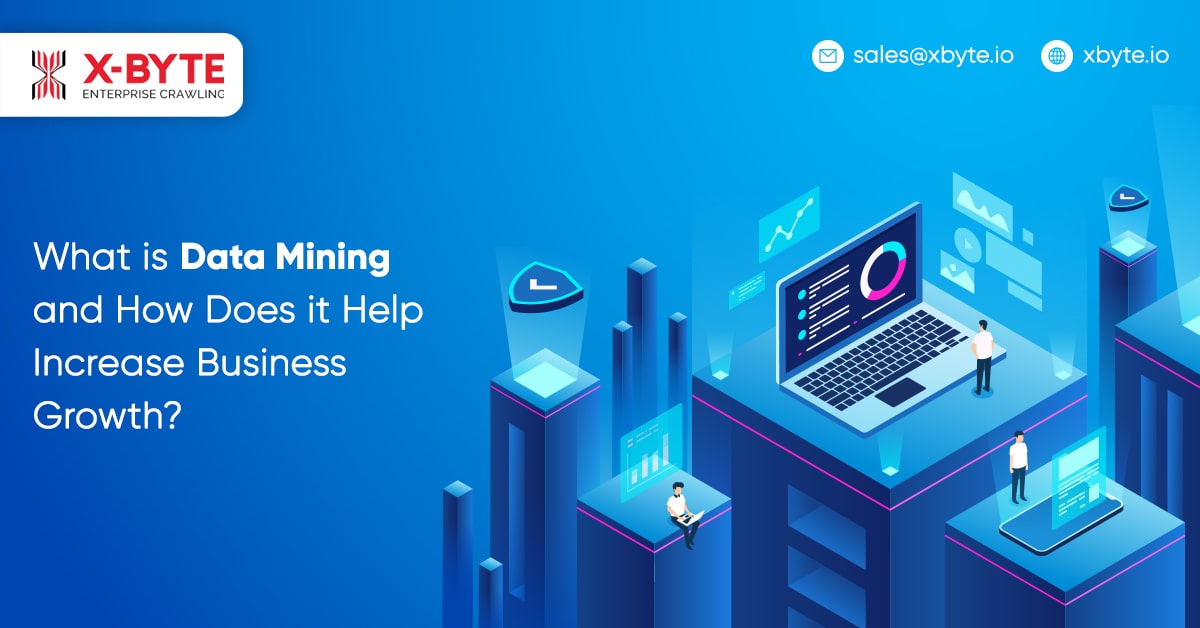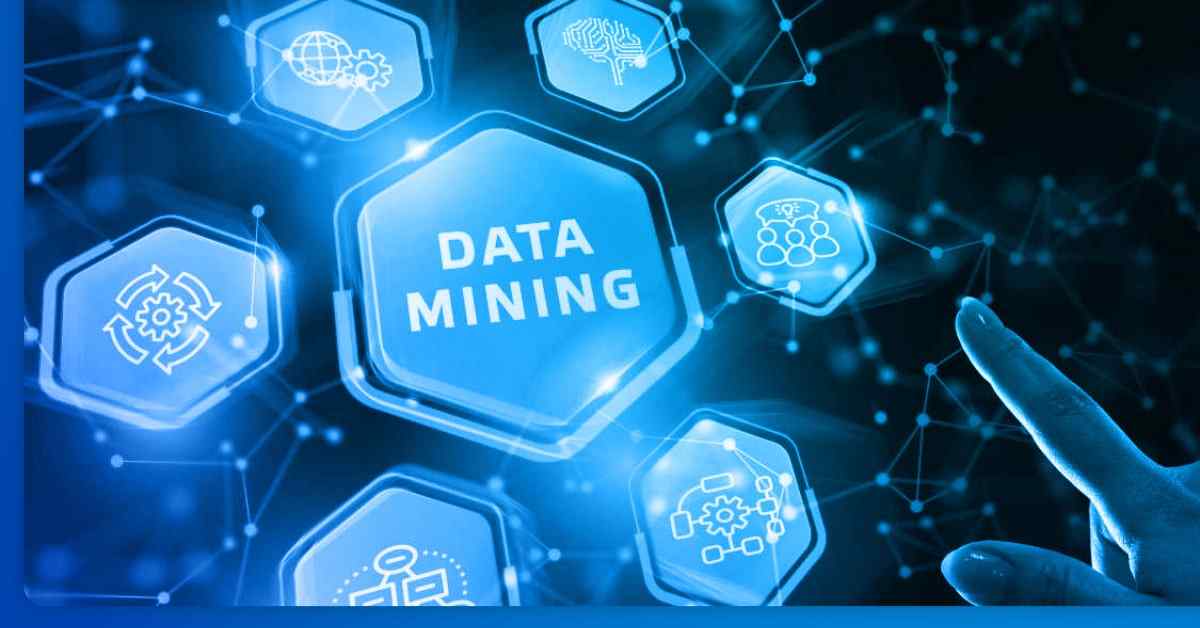
Large amounts of publicly available online data must be collected to make appropriate business decisions that result in desired profitability. The fetched data is only worth it if is put to good use afterward. Hence, here we will explain what data mining is and how it can enhance your business growth, decrease expenses, and build better relationships with consumers.
What is Data Mining?

Data mining is analyzing large amounts of data. It is the step once you have completed the data gathering process, for instance, web scraping.
Data mining is the process of cleansing original data, discovering patterns, and creating models to learn more about it. This necessitates the use of statistics, machine learning, and database management systems.
Consider the following data mining scenario: Let’s imagine you’ve compiled a large list of product price data from e-commerce websites and want to utilize it to change your pricing policy. To do so, you will need to first evaluate and comprehend it, or execute data mining.
How Does Data Mining Process Work?
Data mining process includes various steps such as data collection to displaying valuable information. Its main purpose is to use observations, relationships, and correlations to summarize data.
The main four steps that Data Mining involve are:
Setting Goals, Organizing Collected Data, Implementing Algorithms, Assessing Outcomes.
Setting Business Goals

For effective data mining results, well-defined corporate functions are important. In order to describe business challenges, the data team (analysts, scientists, and engineers) must collaborate with the other stakeholders involved, which leads to informative data inquiries and frameworks. Analysts are sometimes required to provide additional information in order to properly comprehend the context.
Preparing Data

Being clear with the issues, data analysts can discover solutions to the questions. After collecting the relevant information, they will fix the errors by removing duplications and locating missing values.
To minimize future processing delays, some datasets may need to reduce the number of dimensions. It’s up to data analysts to maintain the most important features to assure a model’s correctness.
Pattern Mining

Data scientists investigate relationships such as sequencing, connections, and correlations, depending on the nature of the data analysis selected. Although high-frequency trends may have a larger use, specific variances in a dataset might reveal regions of probable fraud.
Deep learning data mining methods can be used to categorize or cluster datasets during pattern mining. If indeed the data entry is labeled (supervised learning), a classification algorithm or regression is used to forecast the likelihood of a given assignment occurring.
Separate data sets are compared to discover commonalities and categorize them based on these features if there is no label to the dataset. (Unsupervised learning).
Discovering Solutions

After the data has been sorted, it’s time to evaluate and analyze the results. Validity, uniqueness, utility, and comprehensibility must all be satisfied throughout the review of findings if they are to help a firm achieve its objectives.
Data Mining Methods
You may use a variety of techniques in your data mining process. Pattern or anomaly detection is one of the most frequent data mining applications, which may be accomplished using a variety of approaches.
The Most Popular Data Mining Methods are
Association Rules

This approach uses an if-then rule to detect links between components in a dataset. Two requirements are included in the association rules: support and confidence. The frequency of a given component in a dataset is measured by support, whereas confidence indicates the number of times the if-then sentence is valid.
Neural Network

This approach aims to train data by imitating human brain interactions through connected layers. Components, weights, bias, and outputs are all nodes. If the output value exceeds a certain threshold, the data is sent to the next layer.
In this approach, neural networks acquire this mapping function and adapt as per the loss function, in conjunction with supervision. We can trust the model to be correct when the loss function is near to zero.
Classification

This method divides components into categories that are created throughout the data mining process. Decision trees, k-nearest neighbor (KNN) algorithms, and logistic regression are all instances of classification.
Clustering

Based on data mining applications, this data mining approach combines components with similar features into clusters. Hierarchical clustering, k-means clustering, and Gaussian mixture are examples of this approach.
Regression

This is an extra way for determining data associations. It involves making predictions about data values based on specified factors. Consider linear regression, regression analysis, or decision trees as examples.
Sequence Analysis

In certain types of data mining, researchers search for signs that connect one course of activities or values to the next.
Advantages of Data Mining

In general, data mining assists organizations by allowing them to discover hidden resources, patterns, relationships, and anomalies in databases. All of these factors work together to improve decision-making and strategic planning.
Here are some of the specific benefits that data mining may provide:
- Marketing and Sales Efficiency: Data mining may help both marketers and salespeople better understand client behavior and preferences. This assists in the creation of focused advertising campaigns, the improvement of lead conversion rates, and the sale of items or services to current consumers.
- Improvements to the Supply Chain: Companies can simply estimate product sales and manage all suppliers if they keep market trends in mind. You may also utilize data to improve warehouse, shipping, and other logistics management.
- Customer Service: Businesses can immediately detect consumer difficulties and use this data in customer calls and online conversations.
- Effective Risk Management: Risk managers and company leaders can successfully analyze and manage a corporation’s financial, legal, cyber, and other risks.
- Cost Savings: Data mining may help a firm save money by ensuring operational efficiency in operations and reducing wasteful spending.
Overall, incorporating data mining into your daily operations is likely to result in increased revenue and profits, as well as a competitive edge over other businesses in the area.
Web Scraping vs. Data Mining
Web scraping is the process of extracting data from the internet and storing it in a manner that is easy to analyze.
Data Mining will not require any data collection. Rather, it is everything you do with your data when it’s in place and in a usable format preparing it, looking for patterns, and assessing what you have discovered.
Conclusion
Data Mining is another step necessary after collecting the data from the internet. It can potentially help teams across the organization, including marketing, customer support, sales, risk, and more.
All of this works together to help you use data mining to create well-informed business decisions that result in profit and income.
For more details, contact X-Byte Enterprise Crawling today!!
